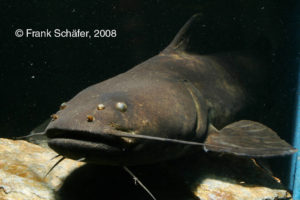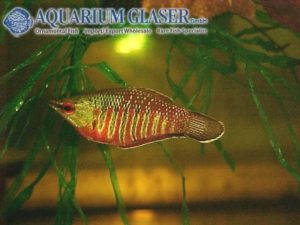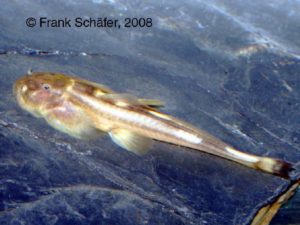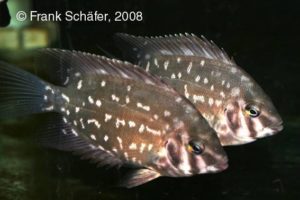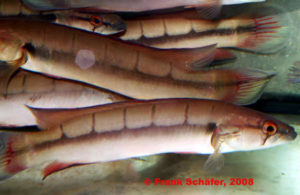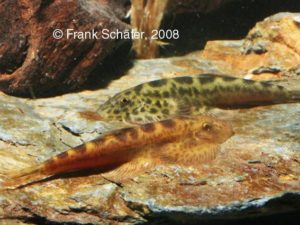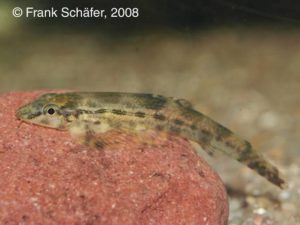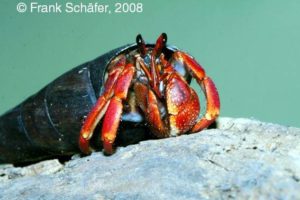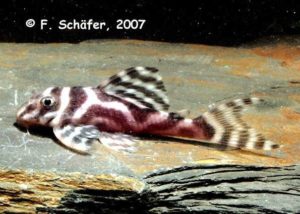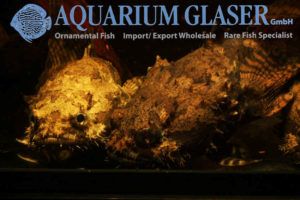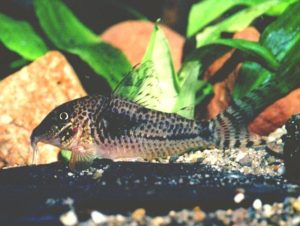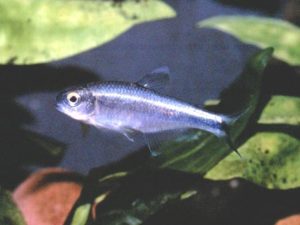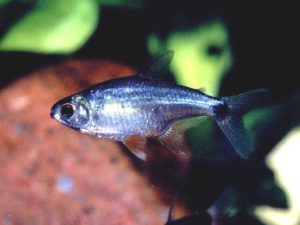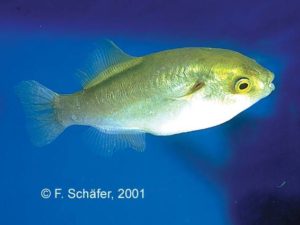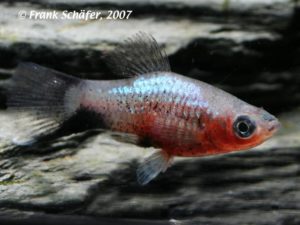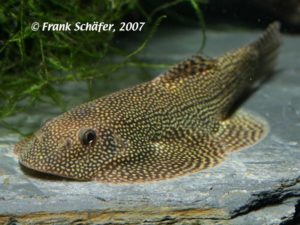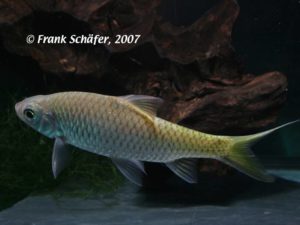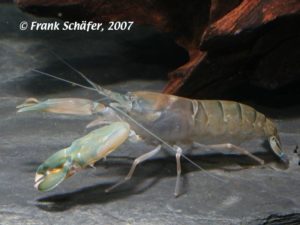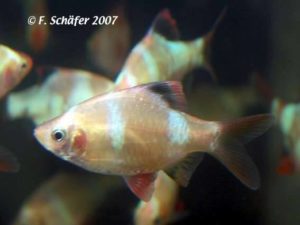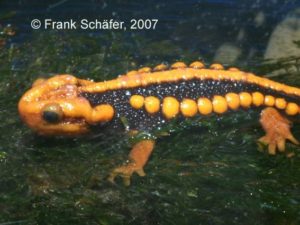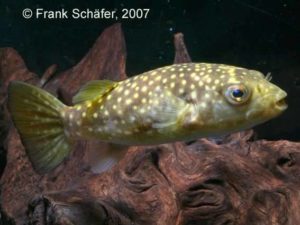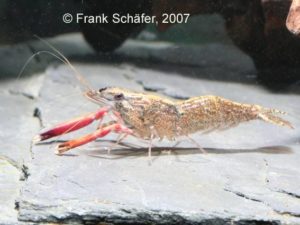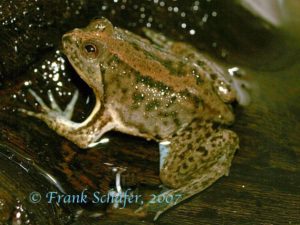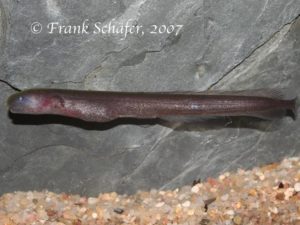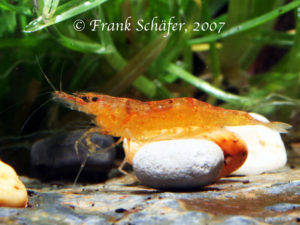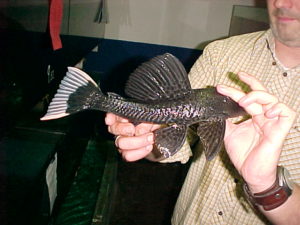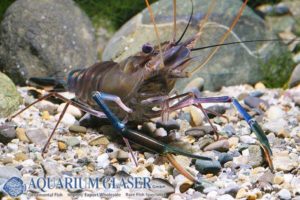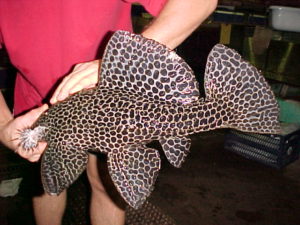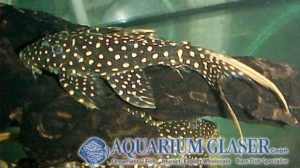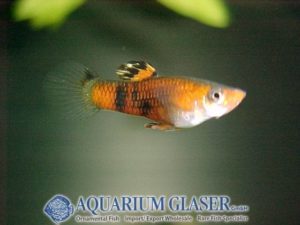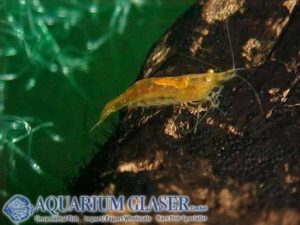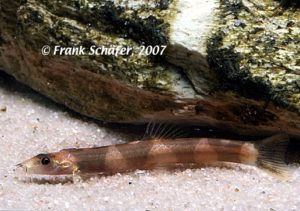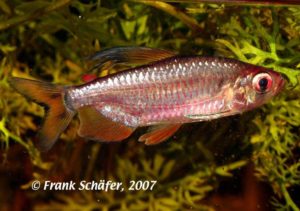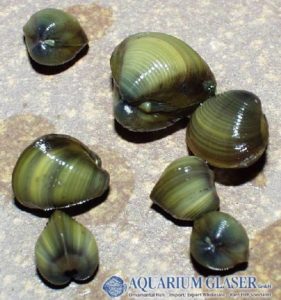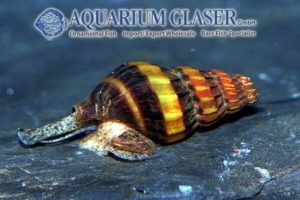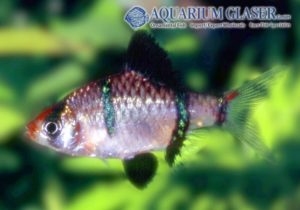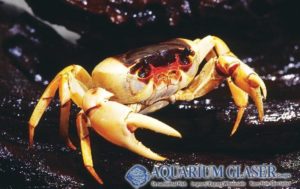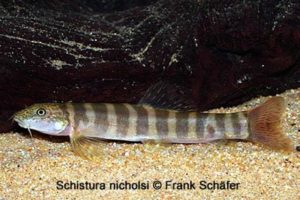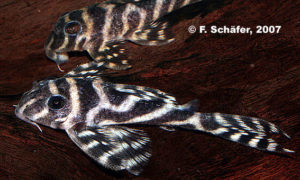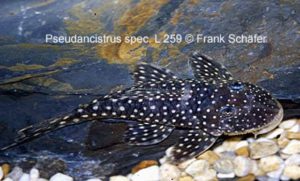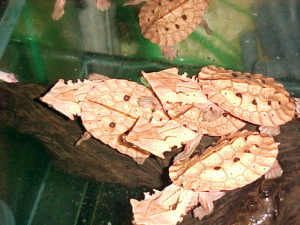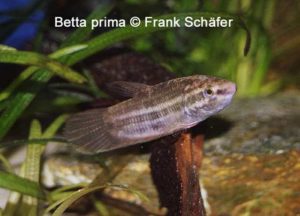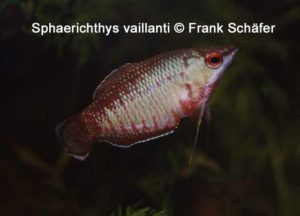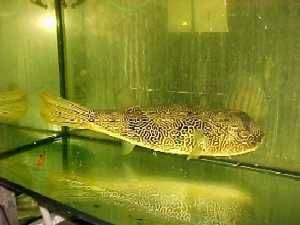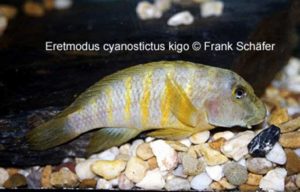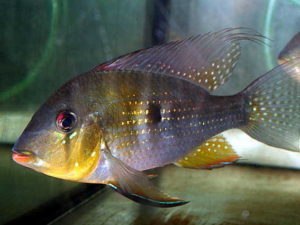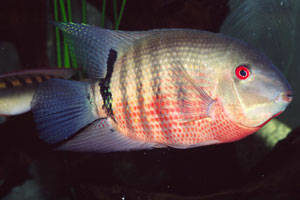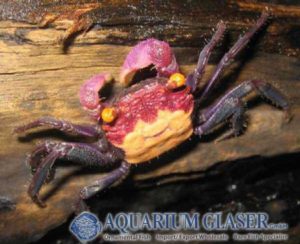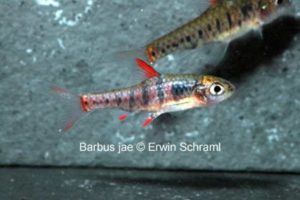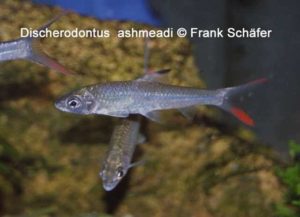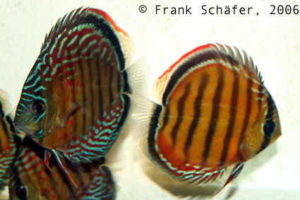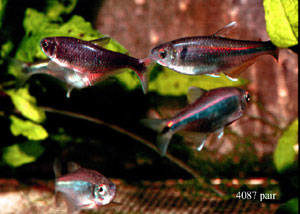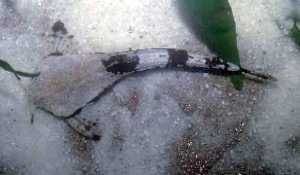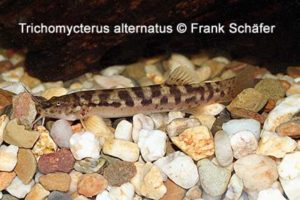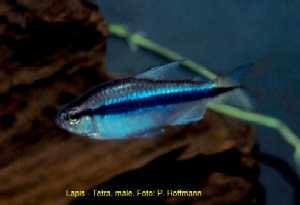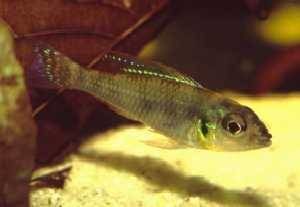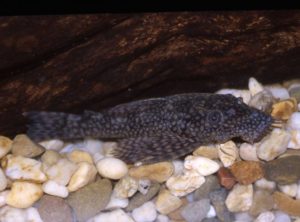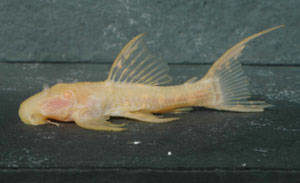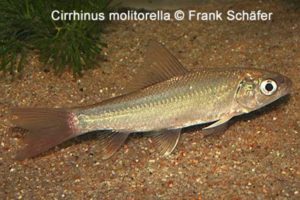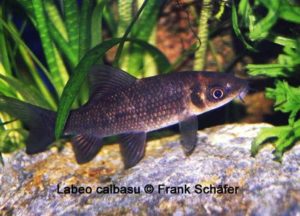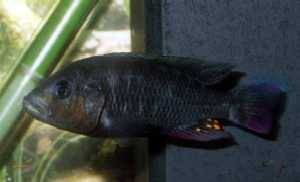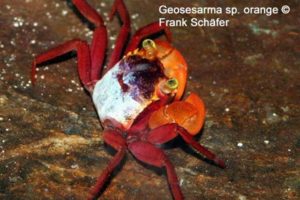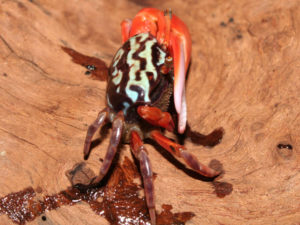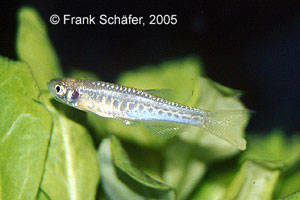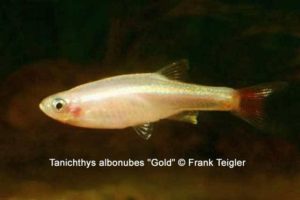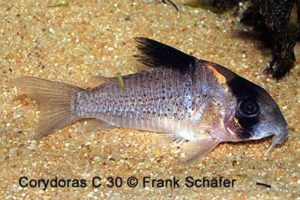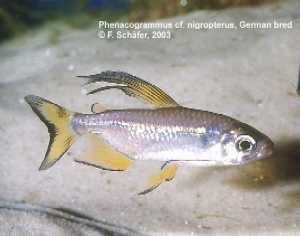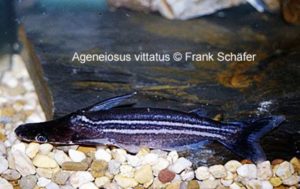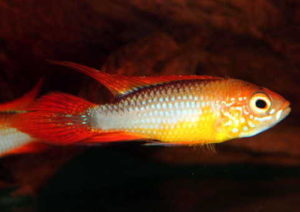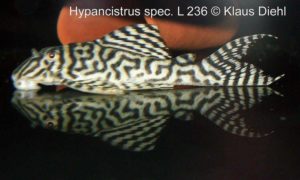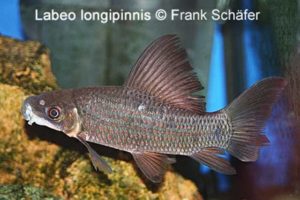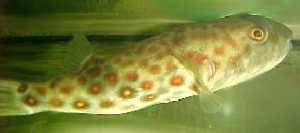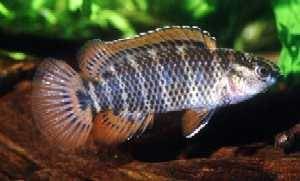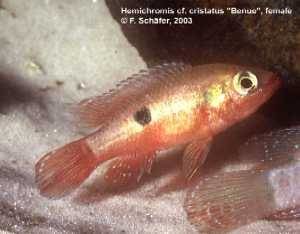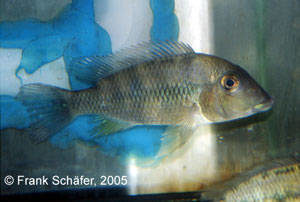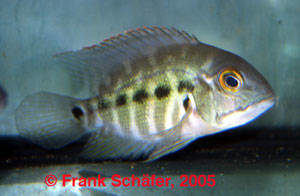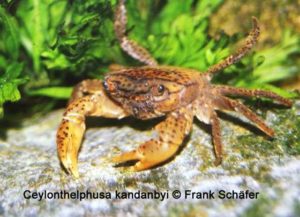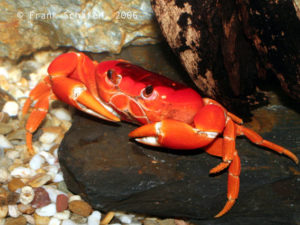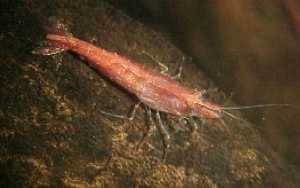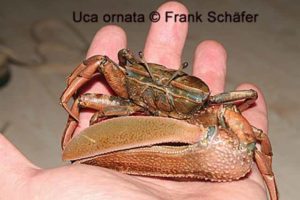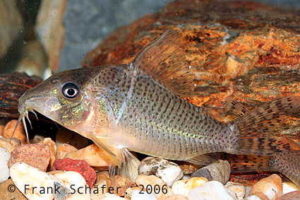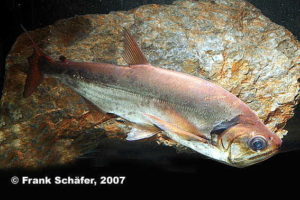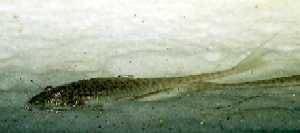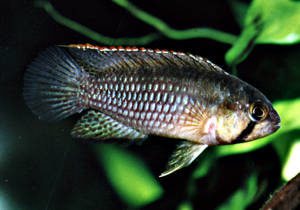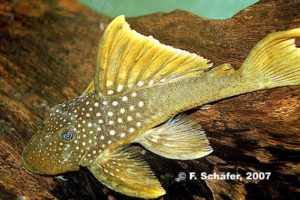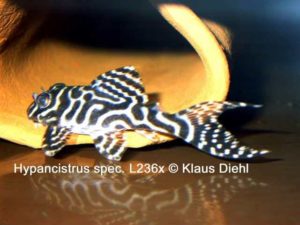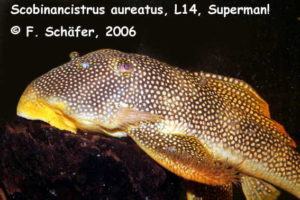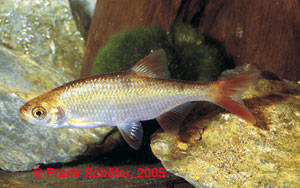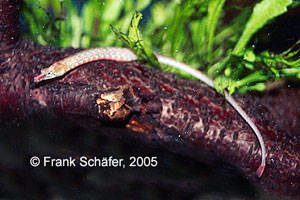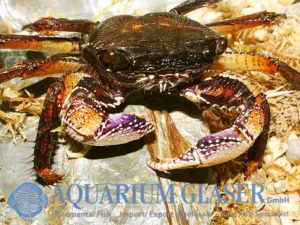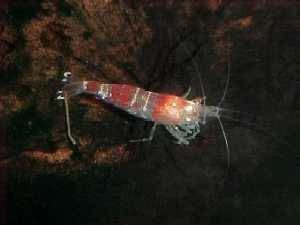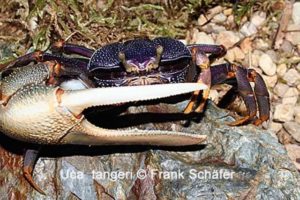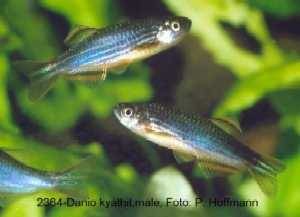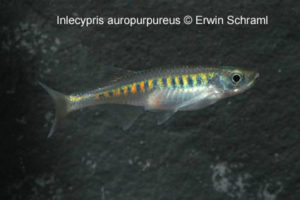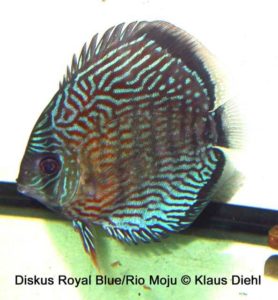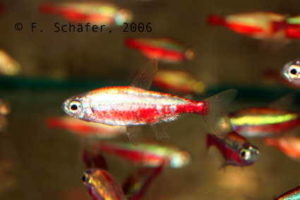(09.May 2008) A real strange fish was now imported by us from the south of Brasil. This fish belongs to the Glanidium family and shows a size of about 40cm, which is really big for such an fish. They look very calm, but during the night they start to eat….everything what they can get into their big […]
Fish Archive (3083)
-
-
Sphaerichthys vaillanti
(25.April 2008) A real beauty made by nature is currently available: Sphaerichthys vaillanti. This fish, which is called red chocolate gourami, is without any doubt the best looking one of all 4 Sphaerichthys members. The water should be soft, not too cold (25-29°C) with a low pH (4,5-6,5). If you offer these water parameters, you […]
-
Oreoglanis siamensis
(21.April 2008)…and again we got something very rare: Oreoglanis siamensis. But only a very few pieces. They live in the Mekong area and the Chao Phyraya basins. In the northern part of Thailand you can find them in the mountain area of Mae Nam Ping and Doi Chiang Dow. They are found in fast floating […]
-
Uaru fernandezyepezi
(9.April 2008)For the first time we can offer some offspring of Uaru fernandezyepezi. The home of this extremely rare cichlid is in the border area of Colombia and Venezuela, where they occur in the area of the Rio Atabapo. From there origin some challenging fishes such the Altum-Angels. Their requirements are similar, the water hardness […]
-
Crenicichla sp.ATABAPO FIRE Venezuela
Last week we got a very small amount of one of the most beautiful pikecichlids: Crenicichla sp.ATABAPO FIRE Venezuela. Sorry for the bad picture, but it was taken directly in a tank in our facility, not in a photo-tank. But it shows how nice this fish is!
-
Sinogastromyzon wui
(18. Feb.2008) Last week we received this loach which was described by FANG 1930. Their habitat is from the Nanpan-jiang and Xi-jiang basins in Guangdong to Guanxi provinces in China. The maximum size is about 8-10cm. They should be kept in cold water, not over 22-23°C, and they have very high oxygen requirements. To offer […]
-
Homaloptera tweediei
(14.Feb.2008) The adult size of the gecko-loach, Homaloptera tweediei, is only approx. 4cm. This species is very interesting for the hobbyists, because they can be kept for a longer period in a water temperature of more than 24°C. The main reason is the origin in central Thailand. After acclimatisation they are very thankful and easy […]
-
Coenobita cf.pseudorugosus
(11.Feb.2008) Again a new “crawler”: Coenobita cf.pseudorugosus. From Asia we received this super red hermit crab. The conditions to keep them are similar to all other land hermit crabs. Noteworthy are the nice flats they carry: from screwdriver snails of 5-6cm which the hermit quit the leasing contract…because of own requirement….(Photo F.Schäfer, Text R.Neunkirchen)
-
Hypancistrus spec. L 173b
(19.Feb.2008) After a long break back in our stock: German offspring of L 173. This very rare Hypancistrus is probably the most closely with L 46 related species. As juveniles they look like zebras with an irregular stripe pattern. Their final size is a little larger than L 46 L also their clutches are larger. […]
-
Allenbatrachus grunniens
(01.Feb.2008) Toadfish – a funny name for a funny family, the Batrachoididae. There are only 73 representatives of this family worldwide. Their name is coming from noises which they can generate and sounds like the callings of toads. Toadfish have a venomously spine on the gills and their dorsal fin and when you catch them, […]
-
Corydoras sp. C 115/116
(16.Jan.2008) This Longnose armored catfish was caught by Hoffmann & Hoffmann in Peru in a small canyon 50km away from Puerto Maldonado toward Boliva in 2004 and brought along legally. The very variable drawing, from monochromatically grey to big black spots on the sides of body (hence C115 and 116) is interesting. The breeding is […]
-
Bryconamericus/Hemibrycon sp.
(16.Jan.2008) These beautiful, agile, steel-blue shining tetra, which grow up to approx. 6cm were caught by Hoffmann & Hoffmann in a clearwater stream in Peru nearby the Andes in 2004. Six animals reached Germany and could be bred. They do not need much warmth, 24°C are sufficient. The youngsters grow slowly. An exact classification was […]
-
Cheirodon sp. (A)
(16.Jan.2008) The most colourful type of the three different Cheirodon/Odontostilbe species caught by Hoffmann & Hoffmann in Peru in 2004, which cannot be classified exactly is Cheirodon sp. (A). The animals have red coloured belly- and anal fins, males more intense than females. Also these fish were already often bred. They are productive and fast-growing.(Photo […]
-
Auriglobus silus
(21.Dec.2007) Streched Puffer is his name. This week we recieved this frisky puffer from Thailand. They are easy to keep and do not need special water parameters. In bigger sizes they can tend to fight between themselves. All in all it is an interesting puffer, which will be kept mainly from experts or experienced hobbyists. […]
-
Platy BLEEDING HEART BLUE COMET
(19.Dec.2007) Also this new bred variety arrived here last week. Currently we only have a few pieces in stock, which are males only. The coloration “bleeding heart” – the deep red basic colour, which is only restricted to the below body half – can only appear at males for genetic reasons. The females cannot be […]
-
Sewellia sp. Spotted
(19.Dec.2007) This, very attractive, probably scientifically not described hillstream sucker reached us from Vietnam. They remember on Sewellia lineolata but their point pattern is finer and also is the for S. lineolata characteristic “stripe” missing. Like all hillstream suckers they come from fast flowing water, there they inhabit rapid flowing streams where they graze on […]
-
Poropuntius laoensis
(19.Dec.2007) For the first time Aquarium Glaser was able to import this barb, which is sized 20-25cm and which is quite unnoticeable at first sight. It usually residents in clear wood bourns in the catchment area of the huge Mekong River. The peaceful animals turn out to be very colourful, if you look closely. Especially […]
-
Alpheus cyanoteles
(17.Dec.2007) Pistolshrimp…that`s what they are called. Currently we have a very limited number in stock. Generally this is a brackish item, which is totally adapted to live in freshwater. They come from the peninsula of Malaysia. They can create a sound like the shoot of a pistol, which is why they are called Pistolshrimp. You […]
-
3 new varieties of Barbus tetrazona
Since last week we can supply 3 new breedingforms of the Tiger-Barb. They are called gold-green-stripe: albino-platinum: and green-platinum: From now we will have those on a regular base in stock.
-
Tylototriton shanjing
(13.Dec.2007) One of the most beautiful representative of the genus Tylototriton is available: T.shanjing. These beauties comes not on a regular base. Their habitat is the middle and western part of the chinese province Yunnan, Laos & Myanmar. They live in subtropical forests in an altitude of around 2000meters. The females lay up to 300 eggs […]
-
FIRST TIME IMPORTED: Arothron firmamentum
Just yesterday we got from Burma an marine pufferwhich was caught in pure freshwater: Arothron firmamentum. This is the first time that this item was found in freshwater and we hope that we can provide more details about them soon.
-
Macrobrachium sp.RED CLAW
This amazing shrimp arrived last week: Macrobrachium sp.RED CLAW. We received a very limited number of this item, which is coming from east Borneo. Our supplier told us that he never shipped them to Europe before. This picture is showing a male, if you click on the small blue fish next to the picture, you […]
-
Occidozyga lima
(30.Nov.2007) From now available on a regular base : Occidozyga lima, the floating frog. These funny guys come from Indonesia. They are easy to keep and should be kept in small groups of at least 10 pieces. They only grow up to 3-4cm and show no sexual dimorphism. They eat all kind of small flies like Drosophila, but […]
-
Isichthys henryi
(29.Nov.2007) Currently in stock: one of the rarest Mormyrids in the world: Isichthys henryi. Our supplier from Guinea informed us that this item appear only 2-4weeks per year! So it only can be called luck to have nearly one hundret pieces right now in stock! To keep the single is recommended, because they are agressive […]
-
Caridina cf. propinqua
30.Nov.2007) Now we are happy to have them available in big numbers : the mandarinshrimp, Caridina cf. propinqua. Yesterday we received a good quantity of this beautiful shrimp from our supplier . Their origin is the isle of Sulawesi. So far we can say are they easy to keep; the females grow up to 2cm […]
-
Hypostomus isbrueckeri
(28.Nov.2007)At the moment we have a group of nearly full-grown Hypostomus isbrueckeri in stock. The here pictured male is easily distinguishable from its partners by the bright colors of the caudal fin. This is probably the only Loricariid species which shows such a pronounced gender difference. Their origin is the border region Brazil, Argentina, and […]
-
Macrobrachium rosenbergii
(26.Nov.2007)The genus Macrobrachium rosenbergii is playing a very important role in the Aquaculture in many regions of asia. Mainly in Thailand they are bred in huge numbers for human consumption. This shrimp belongs to the family Palaemonidae and from time to time they are mported to Europe. But when you find this very nice shrimp […]
-
Megalancistrus parananus L234
-
Pseudacanthicus spec. Typhoon
(2nd.Nov.2007) For the first time we can offer Pseudacanthicus spec. Typhoon. This extremely attractive Cactus Pleco comes from Brazil, its origin is kept as a secret, so that no information concerning the river were they have been caught can be made. In the appearance they reminiscent of Pseudacanthicus spec. “Titanic” L 273, the colour (black […]
-
Micropoecilia picta RED
(15.Jan.2008) FINALLY in good quantities available: MICROPOECILIA PICTA RED. From now we will have this beautiful fish on a regular base in stock. We get it from our breeder by pair. A much better availability is now guaranteed. (Photo & Text R. Neunkirchen)
-
Caridina cf. propinqua /Orange Shrimp
A NEW ARRIVAL of the week: Cardina cf. propinqua! This beautiful orange shrimp arrived yesterday. The latin name is Caridina cf. propinqua. We got a limited number of this extreme nice shrimp. Basically they are easy to keep, but if they will start to loose their colour, you just have to reduce the pH. This […]
-
Schistura pridii
(19.Oct.2007) Last week we received another new item: Schistura pridii. This beautiful small loach (grows up to 4.5cm) comes from Thailand. Exactly they were found in the upper Chao Praya Bassin in the Chiangmai province in the north of Thailand. They come from cool (18-24°C) & fast floating rivers, containing hard and alkaline water, which […]
-
Phenacogrammus cf. ansorgei
(12.Oct.2007) Last week we received a real beauty from Zaire: Phenacogrammus cf. ansorgei. This species grows up to 8cm and was caught in the Lac Mai Ndombe. In the past this lake was called Lac Leopold II. This is a “blackwater” lake, this means all fish from there should be kept in a pH of […]
-
Corbicula sp.
From Corbicula sp., a maximally 3 cm long mussel, we can offer 2 different colour types. They are hermaphrodites, whose larvae do not, contrary to some other kinds of mussels, exhibit parasitical stages. Since they filter their food from the water, they clean it of suspended matters, bacteria and protozoa. So they can be called […]
-
Anentome helena
mg class=”alignnone size-full wp-image-147928″ src=”http://www.aquariumglaser.de/wp-content/uploads/Anentome-helena.jpg” alt=”” width=”591″ height=”394″ /> From now available: the snail-eating snail ANENTOME HELENA. This item coming from asia, is perfect cleaning your tank from snails. The snail is finding her victims with her trunk. With a total length of about 1,5cm is this item also suitable for very small tanks, in […]
-
Barbus (Puntius) tetrazona BLACKFIN
We got them! For the FIRST time in europe we have a small amount of german bred “Black Finned Tiger Barbs” (Kapuas area)in stock! This is the REAL Puntius tetrazona. In 2006, a privat hobbyist imported 8 pieces of this species. Mr. Dieter Bork bred a a small amount for us, which is actually available. […]
-
Demanietta sirikit
Just last week we got a few pieces of the beautiful thai crab Demanietta sirikit! This crab lives in 50-100cm long tunnels near by the riverside. They are building their homes so deep until they reach the level of the groundwater. In the mating season they look for a partner. This happens during the rainy […]
-
Subscribe for our newsletter!
As one of the main innovations you can subscribe to our newsletter from now on! No matter if you are our customer or “just” an ornamental fish hobbyist, who is interested in news around his hobby. Simply subscribe to our newsletter and you will be getting informed regularly (until revoked) with news and interesting facts. […]
-
Schistura nicholsi
To an unusually large about 200 species comprehending genus belongs Schistura nicholsi the Redtail Zebra Sand Loach. It originates from the Mekong basin in Thailand and Laos, where it inhabits fast flowing waters on a stony ground. This is to be considered during its aquarium maintenance. In order to ensure a high oxygen content and […]
-
Hypancistrus spec. L 173 Bred
March 2007: Freshly arrived: Beautiful German breds of L 173. For the first time we can offer thereby more than a “handful” of these wonderful rare pieces. The large variability of their pattern is remarkable. The bluish glow is common in all the white of their fins. (Photo F. Schäfer, Text K. Diehl)
-
Pseudancistrus spec. L 259
Pseudancistrus spec. L 259 originates from the surrounding of the city Pimental at the Rio Tapajos. As all Pseudancistrus species the males of L 259 show a characteristic “beard” of Odontodes (dermal teeth) during the spawning season. Contrary to the popular Hypancistrus species L 259 are vegetarians. Therefore Zucchini, cucumbers and further vegetables should be […]
-
Chelus fimbriatus
June 2006: Freshly arrived and very beautiful. From South America reached us few Mata matas. Their in jungle waters protruding camouflage lets it appear remarkable and bizarr in the aquarium.(Photo F. Schäfer, Text K. Diehl)
-
Betta prima
Betta prima originates from South East Thailand and Cambodia and is a member of the Betta pugnax group. They are found foraging along the dense vegetation of brooks, swamps and calm rivers. B. prima is a small species, they can reach the size of about 6 cm. They like well planted, and since they are […]
-
Sphaerichthys vaillanti
Sphaerichthys vaillanti is probably the rarest and most desired species of the Chocolate Gouramies. Their origin is Kalimantan the indonesian part of Borneo. Since they are black water inhabitants, the water equivalents should be adapted in the aquarium to it. This species does best in peat filtered water. Water must be changed often, and a […]
-
Tetraodon mbu
April 2002: Yesterday we received from the Republic of Congo, this beautiful Tetraodon mbu, the real congo-puffer. We got this item in this huge size never before.The maximum size cited in the literature is nearly 70cm. It is astounding how individuals differ in their behaviour: there are shy and also agressive ones. More details you […]
-
Eretmodus cyanostictus „Kigoma“
Eretmodus cyanostictus is among the group of cichlids called gobies. Gobies only occur naturally in the surge habitat of Lake Tanganjika, which is the upper meter of the water at the shoreline. They unique in that their swim bladder is non-functional, meaning that when they’re not swimming, they drop to the bottom like a rock. […]
-
Acarichthys heckelii
January 2007: At present we can offer particularly beautiful Acarichthys heckelii from the region around Santarem. These fish are characterised by an intensive yellow colouring of the body. It forms a beautiful contrast to the red eyes and their magnificent fin rays. Acarichthys heckelii has a large area of origin along the Amazon and the […]
-
Heros severus
Despite the fact that Heros severus is the type species of the Heros genus, this species is the most uncharacteristic representative of this group. This is mainly caused by its reproducing behaviour, which is mouthbreeding and untypical for Heros, because they are all substrate breeding. Also the coloration is different from the other members of […]
-
Geosesarma sp. VAMPIRE
March 2006: They are among us. Fortunately only in a small number: Vampire crabs! With a close look the horror will pack you, remind the ends of its shears very strongly of the carnassial teeth of vampires. At night one would like to meet them with their shiny red eyes in no case. Now in […]
-
Barbus jae
The Jae barb is one rarely out of central Africa imported dwarf barb. With scarcely four centimeters of length they attained full growth and show an attractive red coloration on their fins. The red hue of the fins is more weakly pronounced with the females; their body exhibits predominantly beige-brown tones. In addition the females […]
-
Discherodontus ashmeadi
The redtail barb Discherodontus ashmeadi originating from the tropical Southeast Asia can reach an overall length of up to 14cm. As habitat Mekong and Meklong are indicated. In their appearance the dark dorsal fin mark, as well as the strongly red markings of the caudal fin are particularly noticeable. In their habitat they inhabit brooks […]
-
Diskus Nhamunda rosé
Nhamunda Rosé is the trade name of a strain of the brown discus Symphysodon aequifasciatus axelrodi originated in the Rio Nhamunda (northern influent of Amazon, west the city Alenquer). Now again some Nhamunda Rosé are available. Characteristic for this variety is the partially laminar high red part of the brown primary colour. Thus they are […]
-
New China Tetra
-
Bunocephalus sp. „Black/White“
The banjocat new imported from Peru immediately attract attention due to their interesting colouring in contrast to other species of the same relation circle. Therefore some animals are almost unicoloured white while other specimens mainly show some irregular black markings. The care of this species does not differ from that of other relatives of this […]
-
Trichomycterus alternatus
One of the in the aquarium most easy to keep pencil catfishes is Trichomycterus alternatus. This species, originating from the Rio de Janeiro region, reaches an overall length of for 10cm and can be maintained in aquaria starting from 60cm length. These very shy fish, reminding in their appearance of our in Europe native Stone […]
-
Hyphessobrycon cyanotaenia, Lapis-Tetra
This tetra was introduced to us under the name of “Inpaichthys sp. Lapislazuli” in February 2002 by Mrs. Glaser-Dreyer (Aquarium Glaser GmbH). On the (Japanese) internet it is called Lapis tetra. It was imported in a bigger number of pieces without exact declaration of place of discovery. The males are growing up to at least […]
-
Biotoecus sp. „Tapajos – New“
For quite a while Aquarium Glaser imports this dwarfcichlid regularly from Rio Tapajos in Brasil. This Cichlids, which only get approx. 4-5cm can be kept in pairs in smaller aquariums from 50 ltr and up already. If the aquarium is bigger, a larger group can be brought in, but in doing so a slightly surplus […]
-
Ancistrus spec. L 111
This ancistrus, which supposedly originates from Colombia, exhibits similarities to L 89, but like L 156 has round spots arranged in a honeycomb pattern. Unlike these other two L-numbers, L 111 has a uniformly marked iris ring and light/dark grey striped pectoral fin spines. This catfish is said to grow to about 10 cm, and […]
-
Pseudoacanthicus spec. „Albino Titanic“ L 273
April 2005: Only one fish of the albino form of the well-known „Titanic Catfish“ was imported from Belem (Brazil). L 273 is normally extremely variably coloured from fish to fish. As well as splendid specimens with contrasting dark grey/yellow plus orange colouration there are also individuals that are predominantly mouse grey with black dots and […]
-
Cirrhinus molitorella
If you are interested in a larger growing fish, the mud carp Cirrhinus molitorella originating from Southeast Asia, could be the right thing for you. In the list of fishing world records it is quoted with a length by 1 m and applies in Thailand under the name Pa Keng as a strong fighter at […]
-
Labeo calbasu
Labeo calbasu the Orange-fin shark is a real king sized labeo. In its homeland (Pakistan, India, Bangladesh, Myanmar, Nepal, Thailand and South West China) it is a fish for consumption and therefore of importance in the asiatic aquaculture. With a size of up to 1m it is not a fish for the “normal” aquarium. Aficionados […]
-
Haplochromis sp. Mburo Blacky
The “Mburo Blacky” is coming from Lake Mburo in Uganda. This species is undescribed until now and grows up to 12cm. It does not dig and do not eat plants, but it is rather agressive and therefor those fish need bigger tanks (1 meter in length and up) in which they can find places to […]
-
Geosesarma sp. „orange“
March 2006: The mandarin crab, a further still undefined Geosesarma species, reached us these days from Sulawesi. It is characterised by a very intensive red-orange colouring of the legs and particularly the claws as well as bright yellow eyes. Thus it represents a beautiful coloured contrast to the last week introduced vampire crab. Whether a […]
-
Uca annulipes
May 2005: One of the most beautiful fiddler crab, Uca annulipes has been available now. Fiddler crabs, a family of 65 species, live worldwide in tropical and subtropical areas where they inhabit beaches and swamps. They reach a length of no more then 2.5 to 3 cm. The male animals have one large and often […]
-
Danio aesculapii (=Danio sp. „Pantherinus“)
These minnows originate from Burma, does not grow over 4 cm and is therefore the smallest representative of the Danio genus. But now this beautiful barb fish has been imported by Aquarium Glaser and is now available for the dedicated aquarium hobbyist. As with all representatives of the Danio family, D. sp.„Pantherinus“ is a schooling […]
-
Tanichthys albonubes „Gold“
Tanichthys albonubes “Gold” is a selection of the well-known White Cloud or White Cloud Mountain Minnow. They were imported since the end of the 30's of the past century and were called at that time “Working Man's Neon” or the “Poor Man's Neon”. This referred on the one hand to its attractive colouring, otherwise it […]
-
Corydoras sp. C 30
Corydoras C 30, a scientifically still not described species, originates from the area of the Amazon delta (Federal State Amapa) in Brazil. In its appearance it reminds of Corydoras melanistius a further north in Surinam and Guyana occurring species. Like all Corys C 30 should be held not in a to small group (5 – […]
-
Phenacogrammus cf. nigropterus
This new African tetra, presented by Dieter Bork in “Das Aquarium” 12/01 as “pastel-congo-tetra”, comes from Lake Maindombe (also known as “Lac Leopold II”) in the Democratic Republic Congo (Zaire). Ornamental fish breeder Winter was able to multiply them in a bigger number of pieces. The fins of the males are pulled out beautifully and […]
-
Ageneiosus vittatus
July 2002: For the first time we could import Ageneiosus vittatus from Peru. Slopehead catfish of the genus Ageneiosus are particularly noticeable by its strongly flattened head. These predators can reach an overall length of 30 cm. For the maintenance large basins are necessary. A dark bottom, some stones and bogwood should be brought in […]
-
Apistogramma agassizii „Fire Red“
September 2006: Few days ago we received a delivery of fishes from a well-known German breeder. The here introduced Apistogramma agassizi „Fire Red “increases the heartbeat of each Apistogramma fan. The strong red of the caudal -, dorsal – and anal fin forms a fantastic contrast with the blue-yellow body colouring and a dark longitudinal […]
-
Ancistrus spec. L 352
Our photo shows a pair of Ancistrus spec. L 352, one with 6 – 7 cm very small remaining loricariid from the Rio Iriri. In the view from above the different body forms can easily be be recognized. This and the characteristic beard of the males makes a differentiating of the sexes quite easy. As […]
-
Hypancistrus spec. L 236
„Simply the Best “: Some days ago we could import some of this beauties. With a size of approx. 10cm the white of the here illustrated male shows a fantastic intensity. It seems that one of imported fishes is a not less beautiful female, and so we hope to be able to offer some days […]
-
Labeo longipinnis
december 2005: For the first time in Europe we can present Labeo longipinnis from the Congo River to you. This about 30 cm long growing Labeo is not noticeable by a particularly spectacular design or colour. Due to its lively manner, beautiful form and fins it can become nevertheless a genuine “eye-catcher” in the community […]
-
Tetraodon pustulatus
TETRAODON PUSTULATUS was caught in Cross-River in Cameroon. External shape and behaviour of adult animals remind one of Tetraodon mbu. The maximum size is quoted with 36cm in literature. Young animals being kept together do not show any injuries so that it is safe to assume that they are not very aggressive. Tetraodon pustulatus has […]
-
Badis corycaeus (formely: sp. Putao)
This new, brown-red Badis was imported from the borderland of Myanmar and China. They can can be kept even in cooler temperatures and are easily satisfied. Also bred ones are already available. (Photos & Text D. Bork)
-
Hemichromis cf. cristatus „Benue“
This beautiful cichlid comes from the Benue-river. At least the females grow up to 5cm, the males reach their maximum size with 7cm. Among themselves they are peaceful and they also can be kept with other fish. But there is a slightly rough behaviour, which is typical for all red cichlids. But much less than […]
-
Geophagus crassilabris
Very large animals, up to 20 cm, came to us from Colombia. These beautiful fish came as well from the Rio Chacu. These eartheaters live in nature in a habitat of moderately flowing streams and rivers. Remarkably for this group of eartheaters is the way they breed their eggs, not as normally in the throat […]
-
Hoplarchus psittacus
This, by specialised hobbyists of large South American cichlid, well known species is only very rarely offered to the public. Our animals were imported from Columbia. The best way to take good care of these beautiful cichlids, which can grow up to 40 cm, is to keep them in large fish tanks with plenty of […]
-
Ceylonthelphusa kandanbyi
The leopard crab Ceylonthelphusa kandanbyi represents an attractive addition to the offered crustaceans. This 1999 scientifically described species originates from Sri Lanka where it is found in the Bentota river system. According to statement of our supplier the animals were caught in the proximity of Mathugama city a town in the western part of Sri […]
-
Gercarcinus ruricola
This splendid land crab (Halloween-Crab, Gercarcinus ruricola) occurs in two colour variants, specifically with red or white base coloration. The colour variation involves both sexes. A mixed pair lived together in harmony for several weeks in my terrarium. These creatures are essentially vegetarian, but will occasionally take frozen foods intended for aquarium fishes, eg bloodworm. […]
-
Neocaridina sp FIRE/CHERRY
July 2004: Yesterday we got a limited number of this beautiful shrimp, which belongs to the family of Neocaridina. This type was imported one year ago, but also only in small numbers. They do not demand special water parameters and can be easily fed with common fish food. They can be kept in community tanks, […]
-
Uca ornata
January 2006: For the first time in Germany: The fiddler crab Uca ornata. We are proud to introduce this new species to the pet market. We got only few animals from Ecuador, hope however for further imports of this species. Further information for the maintenance of this at the Pacific coast from Ecuador to Nicaragua […]
-
Danio choprai
From Myanmars rivers and brooks origins Danio choprai the Glowlight Danio. With a length of 4 cm they have already attained full growth. With them as with many swarm fish the effect on the observer rises with the swarm size, a group of 30 animals is always impressing. Glowlight danios are good to keep and […]
-
Corydoras sp. C 71
August 2006: With Corydoras spec. C 71 we could import a further rare species from Brazil. They originate from the Rio Arua in the Federal State Para. With a final size of 6 cm they belong to the medium sized Corys. The requirements for their maintenance might be the same as for other Corydoras species. […]
-
Hydrolycus tatauaia
From Peru some sabre toothed Tiger Fishes of the species Hydrolycus tatauaia came to us. For the maintenance of these impressive hunters naturally roomy aquariums (> 1000l) are needed. Young specimen can be kept in swarms, in the wild even swarms of mixed species were observed. With ageing their aggression potential rises and they become […]
-
Pseudohemiodon thorectes
This catfish coming from Bolivia, belongs to the smallest of his relatives, measuring 13 cm maximum. It is mostly getting imported by travelling aquarium hobbyists. Regarding the water condition this kind is rather adaptable, as guide values of up to 400 µS/cm and a pH-value of 7.6 were measured. Approx. 25°C are quite enough for […]
-
Nannacara sp. Essequibo
This fish was caught in October 2001 in a blackwater-river nearby Rockstone/Guyana. It is a peaceful fish which only grows up to 60mm. The males are more elongate than the females and have clearly visible spots in the dorsal and caudal fins. Water of following parameters was used for breeding and keeping them: 5°dGH, pH […]
-
Baryancistrus demantoides L 200 High Fin
From Colombia we could import expressed beautiful L 200 High Fin. Now we have very attractive partially completely yellow colored specimen of the species Baryancistrus demantoides in stock. They will get only about 15 cm long and remain thereby substantially smaller than the also with the number L the 200 labeled Hemiancistrus subviridis. Compared with […]
-
Hypancistrus spec. L 236x
November 2006: At Christmas we would like to present a star at the catfish heaven. We can offer some offspring of the queen imperial zebra Hypancistrus spec. L 236x, a beautiful and very looked for species. They come from a German breeder, who had the luck that the two from us imported animals formed a […]
-
Scobiancistrus aureatus L 14
December 2006: Last week received we a really impressive, male Scobiancistrus aureatus. With a length of about 30 cm it might be attained full growth. The strong spines on the gill cover (Interopercularodontodes), as well as on their pectoral fins are remarkable. As most L-catfishes from the Rio Xingu they like warmer waters, for their […]
-
Scardinus erythrophthalmus Golden
March 2004: Just in time for the pond season this very attractive variety of the Rudd (Scardinus erythropthalmus) came to us. It is an excellent ecological algae destroyer for your garden pond. The Rudd is an endemic species for the whole of Europe and Asia up to the Aral Sea. It is a friendly schooling […]
-
Enneacampus ansorgii
The small freshwater pipefish originates from Western Africa, from Cameroon to Gabun and in the Zaire- and Ogowe River. These fish inhabit freshwater as well as brackish water habitats. Addition of sea salt (1-2 teaspoons per 10 litre of water) will therefore increase the vitality of these fish. This species, but actually all freshwater pipefish, […]
-
Tahuantinsuyoa macantzatza
The unpronounceable from the Incas empire. So an article about Tahuantinsuyoa macantzatza the Inca Stone Fish could be titled. After fearing over years that they had become extinct, we succeeded to import a larger number of them at the beginning of 2003. For the first time we can offer now both: very beautiful wild caught […]
-
Goniopsis pelii
June 2006: The mangrove crab Goniopsis pelii reached us from the Atlantic coast of Africa. Their orange and blue coloured claws are very remarkable. They owe their name to the mangrove woods where they naturally occur. This by water and land affected biotope has to be reproduced in the terrarium, since they need both habitats […]
-
Neocaridina sp RED CRYSTAL SHRIMP
December 2002: Here we have it: german bred red crystal shrimp. We only got a few pieces, but we expect a limited quantity in the near future. This shrimp of the family Neocaridina is easy to keep and can be kept with not too big growing fish in a community tank (Photo F. Schäfer, Text […]
-
Uca tangeri
The eastern Atlantic from Portugal to Angola, is the origin of the fiddler crab Uca tangeri, where they inhabit sand and mangrove coasts. The to an enormous size grown major claw of the males is remarkable. It is used for attracting the females and to the fight between rivaling males. In their periodically flooded habitat […]
-
Danio kyathit
The Burma-leopard-Danio, Danio kyathit, (“Kyathit”, burmese for leopard) belongs to the many minnows, which came to Europe in a bigger number of pieces lately. We first saw this beautiful “new” Danio in the beginning of 2002 at AQUARIUM GLASER. In contrast to Danio rerio Daniokyathit is much more colourful. Both sexes show intensive orange-red, beautifully […]
-
Inlecypris auropurpureus
Inlecypris auropurpureus belongs to in Inlé lake in Myanmar occurring endemic fish species. That about 6 cm long becoming swarm fish should be held in well planted to not too small (80cm) tanks. Since they are good jumpers, young animals of 1,5cm length can already jump over 10cm high, the tanks have to be completely […]
-
Diskus Royal Blue/Rio Moju
If an increase of beauty and charisma of the at 01.02.06 introduced Diskus variant Red Inferno/Rio Moju is still possible, then by the Royal Blues originating from the same river. When first seeing these fishes I remembered the headline of an old “aquarien magazin” article. In January 1972 Eduard Schmidt Focke a famous german discus […]
-
Cheirodon spec. „Gold Neon“
At present we can offer some Cardinals of the variety „Gold Neon“. This is one of some more in the wild rarely existing colour forms of Cheirodon axelrodi. Actually it is not clear whether this colour forms are distinct species or varieties of the cardinal. At the “Gold Neon” the blue colour strip is replaced […]





